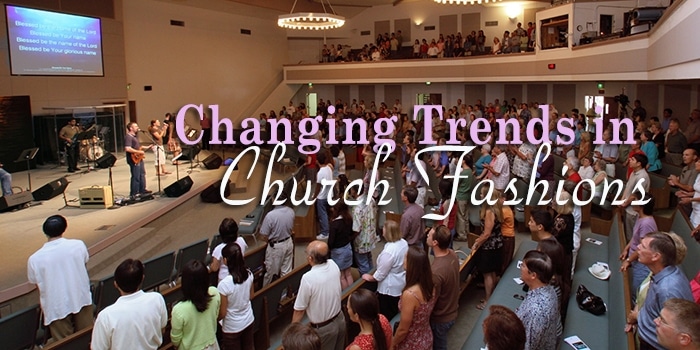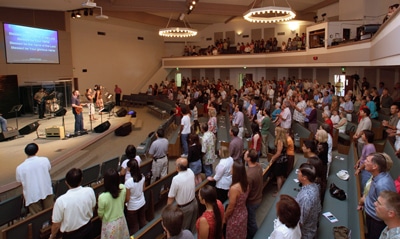
If we could step back in time, say the 1950s, we might not recognize our congregations of today. For example, on a typical Sunday morning, no well-bred Southern woman would think of going to church without a hat, white gloves, a lacy handkerchief tucked into a clutch-bag, high heels and sheer hose with a seam running down the back. For men: a dark suit, long sleeve (starched) white shirt, tie and a fedora. One pastor friend remembers how the men of his church met and decided it would be appropriate to wear a short sleeve dress shirt with a tie for the evening service. The reason? The church was not air-conditioned.
Not only in church are our clothes becoming less formal, but in other aspects of life. Instead of dressing up to board a plane, we journey in comfortable clothes. In fact, gym clothes seem to be the trend for travel.
 Like other factors in our society, church fashions have changed. Often referred to as the “worship wars,” many churches remain divided between traditional and contemporary sounds and styles. Some congregations prefer the casual, relaxed appearance, while others continue the more formal approach. Many believe church should not be a “dress-up” event, but a place where everyone feels welcome, thus making clean and comfortable clothing the excepted norm.
Like other factors in our society, church fashions have changed. Often referred to as the “worship wars,” many churches remain divided between traditional and contemporary sounds and styles. Some congregations prefer the casual, relaxed appearance, while others continue the more formal approach. Many believe church should not be a “dress-up” event, but a place where everyone feels welcome, thus making clean and comfortable clothing the excepted norm.
Casual Church Clothes
“…The Lord does not look at the things man looks at. Man looks at the outward appearance, but the Lord looks at the heart” (1 Samuel 16:7).
Before becoming pastor of New Heights Church in Farmington, Mo., Rocky Good had been on the staff of a more traditional church that served a more traditional congregation. Starting in 2003 with 27 members, New Heights now averages 250 each Sunday.
“We are a Baptist church, but we want to serve all the community, so we took the name “Baptist” off our sign,” Good said. “We are known as the ‘Come as You Are Church’ and our mission is to focus on those non-church people in our community who are not involved in another congregation.”
In striving to build relationships with people, Good wants individuals and families to feel welcome and to find caring, loving people — people who will nurture and help them grow in their Christian walk.
“I tell our people to come dressed as you would for a day of being with your family,” Good explained.
The casual approach to dress carries over to worship and fellowship as people gather for breakfast each Sunday. Good stops by tables and joins groups for coffee. Often these people have been wounded in various ways. They need to talk. They need someone to listen. Healing takes place. People may be led to the Lord, but this is not an explicitly evangelistic time.
In a no-frills building with a concrete floor and several guitars on stage, Good preaches that the Christian life isn’t complicated: “Just love God and love others.”
Serving Amid Fashion Variety
Some black Baptist churches continue the traditional style of dress. Most of the men wear suits, dress shirts and ties. Women dress in attractive suits or dresses and often with matching hats. Although not required, these customs communicate the desire to wear one’s best for Jesus. The adult choirs often wear robes in a color that complements the interior of the building. For the youth and children’s choirs, students wear white shirts or blouses with black slacks or skirts. The uniform look helps place the focus on the music and how it praises the Lord, instead of seeing individual members in the choir.
Francisco Litardo, vice president for marketing and community engagement at Central Baptist Theological Seminary in Shawnee, Kan., sees part of Central’s role as helping students prepare for ministry in a variety of contexts — even a variety of clothing contexts.
“Our American Baptist seminary prepares women and men for seeking God, shaping churches and serving humanity,” he explained. “Our students come from a variety of conditions and we focus on a diverse community in various ways. We hope our students will be equipped for ministry in dress, language and theology. We practice theological hospitality.”
For many ministers, the variety of clothing occurs in their own sanctuary each Sunday.
Aaron Huffman, minister to students at First Baptist Church Lee’s Summit, Mo., serves a diverse group of people. With a mission to “love God, love people, and make disciples,” First Baptist provides three different worship services each Sunday: traditional, blended and contemporary. He believes church attendance should not be a battle over clothing styles.
“Our goal is to make anyone who attends feel comfortable and welcome,” Huffman explained. “Therefore, we have all styles of clothing. Students usually come casual and many wear what they would have worn growing up with parents setting the tone. This may include polo shirts and khakis. Others groups of boys come in shirt, ties and girls in dresses. And some wear gym clothing to church events.”
“Our parents believe that it’s more important for their children to be in church than to be overly concerned with their style of clothing,” he added.
Carolyn Tomlin is co-author of “The Secret Holocaust Diaries: The Untold Story of Nonna Bannister” and teaches the Boot Camp for Christian Writers.

